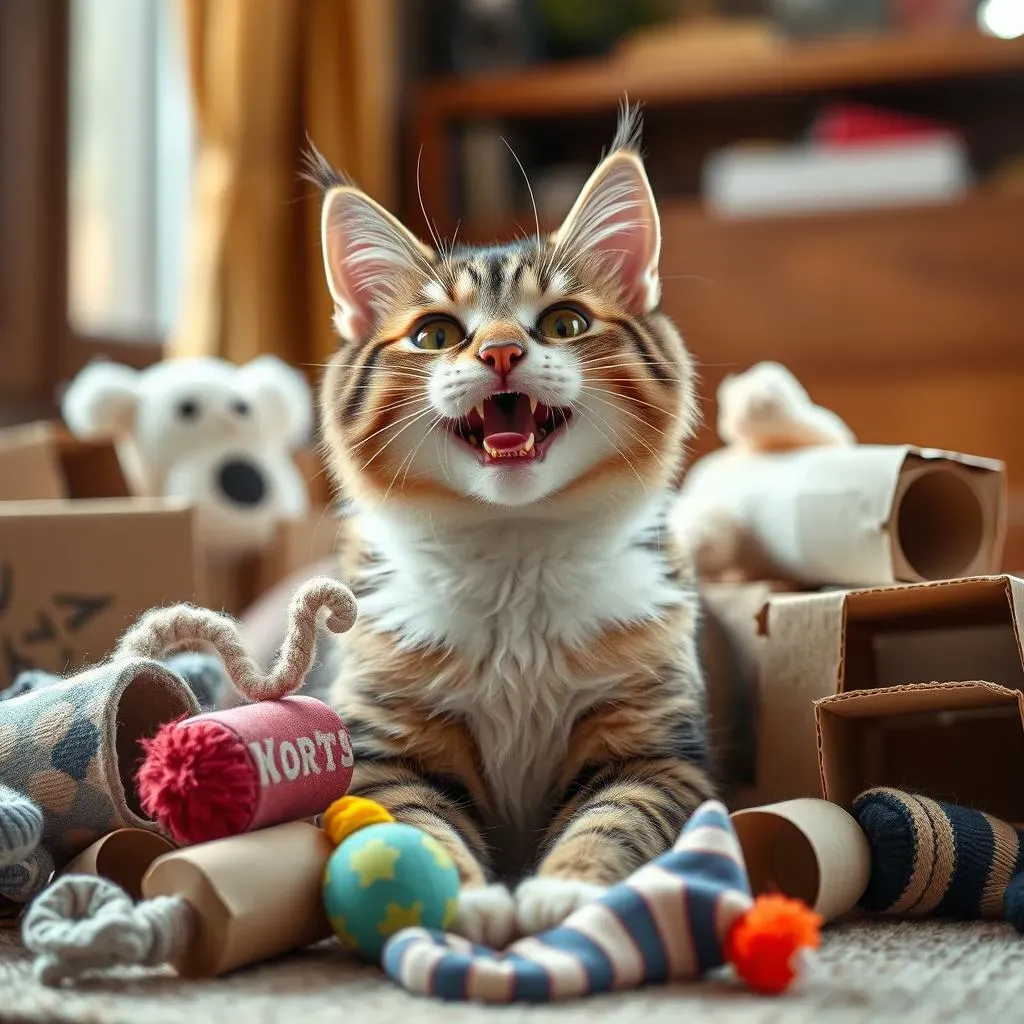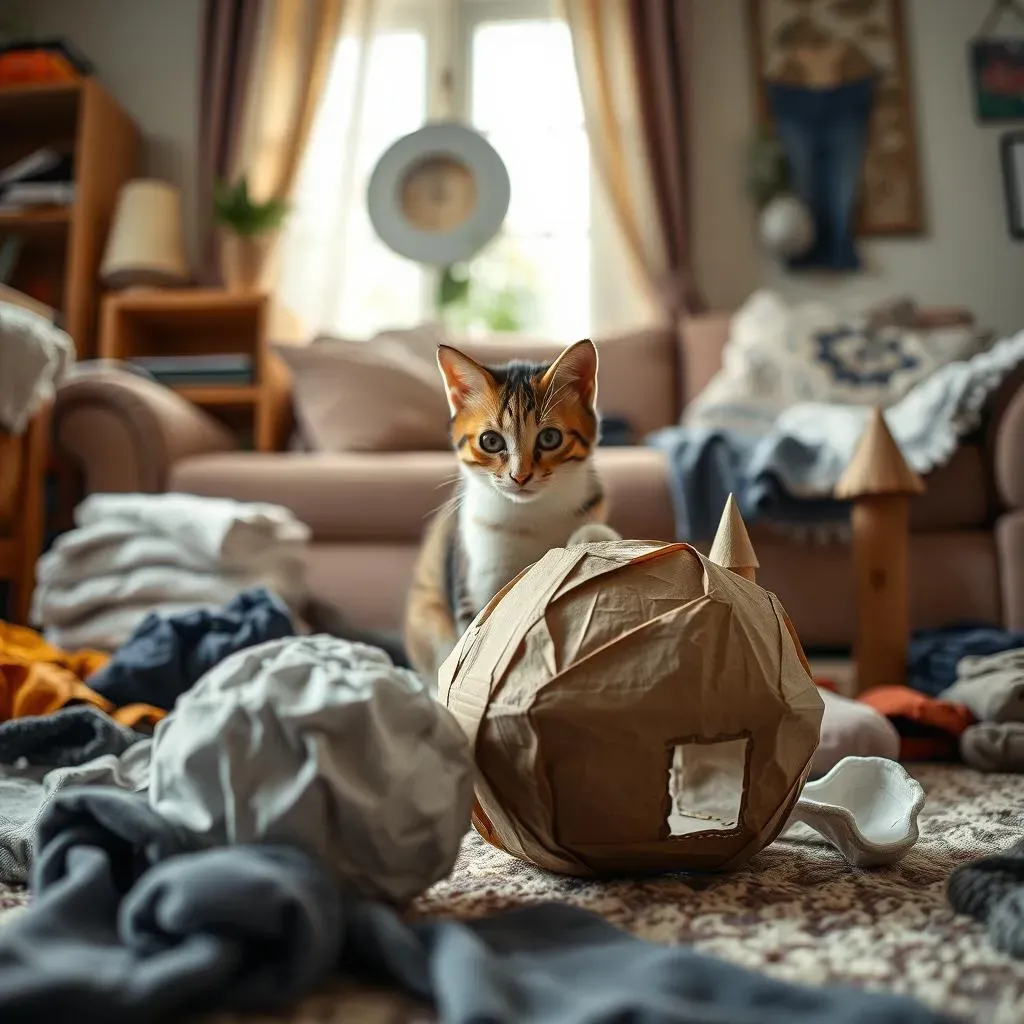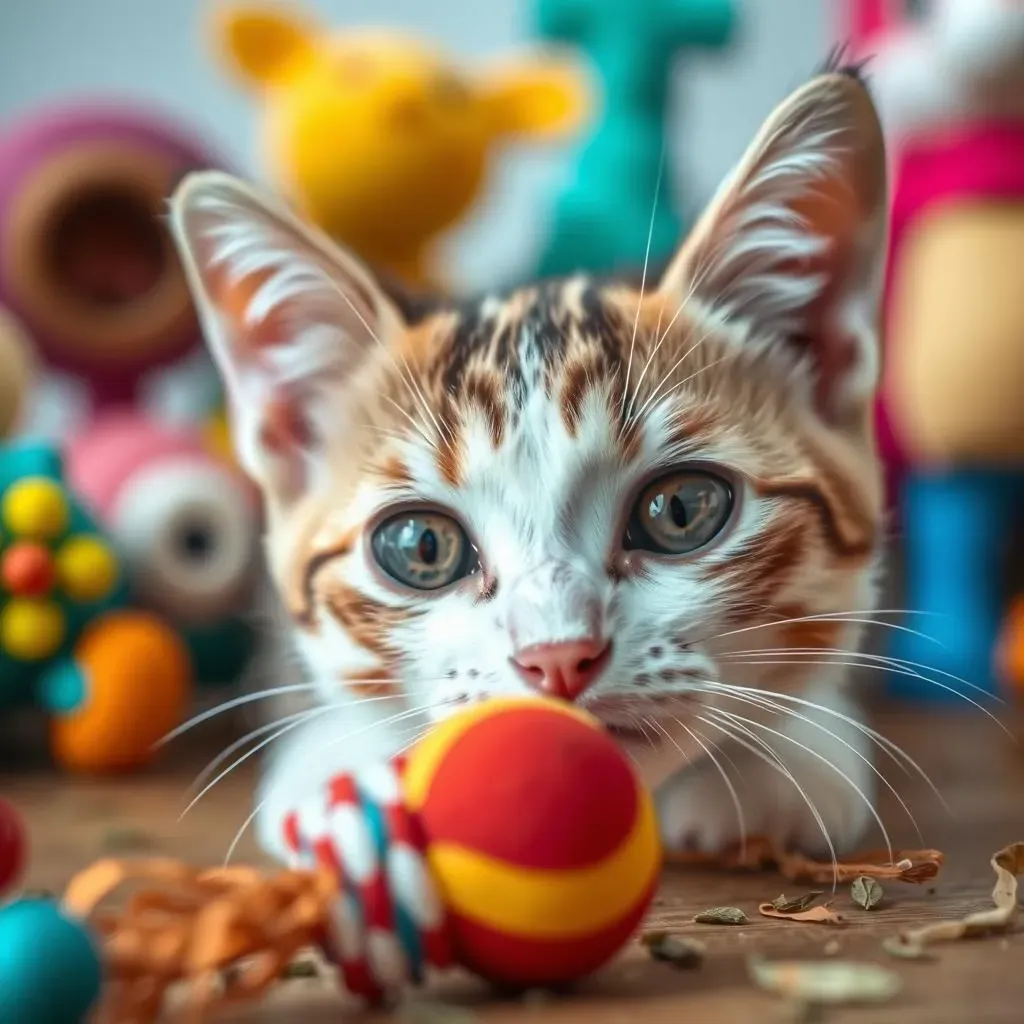Table of Contents
Ever look at your cat batting around a stray bottle cap and think, "I could totally make that"? Well, you're not wrong! Forget those expensive, store-bought toys that your feline friend might ignore anyway. This article is your guide to transforming everyday household items into purr-fectly engaging playthings. We're diving into the world of DIY, showing you just how easy and fun it is to create toys that will keep your cat entertained for hours. From cardboard castles to crinkly paper balls, we'll cover a range of ideas that are not only simple to make but also budget-friendly and eco-conscious. Get ready to learn how to make cat toys out of household items, and prepare for some serious feline fun. We’ll explore why DIY toys are great, then we will show you different ideas, and end with a safety guide to make sure your cat stays healthy and happy. Let's get crafting!
Why Bother Making Cat Toys?

Why Bother Making Cat Toys?
Save Money, Spoil Your Cat
Okay, let's be real for a second. Those fancy cat toys at the store? They're cute, sure, but they can be surprisingly expensive. And let's not even talk about how quickly they end up lost under the couch or completely ignored by your feline overlord. Making your own toys from household items is like finding a secret cheat code for cat entertainment. You're not just saving money; you're also being resourceful and giving those "trash" items a new life. Plus, there's a certain satisfaction in watching your cat go bonkers for something you whipped up from a toilet paper roll and some string. It's like, "Yeah, I made that, and my cat loves it!"
Think about it: that cardboard box that just arrived? Instant cat castle. The empty paper towel roll? A tunnel of fun. Those old socks with holes? A perfect kicker toy. The possibilities are truly endless. It's like having a free toy store right in your own home. And the best part? You can customize them to your cat's specific preferences. Does your cat love crinkly sounds? Throw some paper in a box. Is your cat a hunter? Make some toys they can chase and pounce on. It's a win-win, both for your wallet and your cat's happiness. Making toys is not just about saving some bucks, it's about creating something special for your pet.
Bonding and Enrichment
Beyond the financial perks, making toys is a fantastic way to connect with your cat. It's not just about the finished product; the process itself can be a bonding experience. You get to think about what your cat enjoys, and you're actively engaging in their world. It's like saying, "Hey, I see you, and I want to make you happy." And let's be honest, seeing your cat bat around something you made is just plain heartwarming. It's like getting a little thank-you note in the form of purrs and zoomies. It’s a simple act, but it can have a big impact on your relationship with your furry friend.
Plus, DIY toys can be a great source of mental and physical stimulation. Cats are natural hunters, and even indoor kitties need to express those instincts. A simple toy that encourages stalking, chasing, and pouncing can help keep them entertained, engaged, and out of trouble. It's not just about keeping them busy; it's about keeping them healthy and happy. And a happy cat means a happy home. So, by making toys you are not just keeping them entertained, you are also helping them live their best lives.
Benefit | Description |
|---|---|
Cost Savings | Uses household items to create free toys. |
Customization | Tailor toys to your cat's preferences. |
Bonding | Strengthens the relationship between you and your cat. |
Enrichment | Provides mental and physical stimulation for your cat. |
Easy DIY Cat Toy Ideas Using Household Items

Easy DIY Cat Toy Ideas Using Household Items
Cardboard Creations
Let’s start with cardboard, the unsung hero of DIY cat toys. Those delivery boxes stacking up in the corner? They're not trash; they're a blank canvas for feline fun! Think beyond just a simple box. You can cut out shapes to make tunnels, create multi-level castles, or even fashion a mini-maze for your cat to explore. I once made a mini-city out of old boxes, complete with little doorways and windows, and my cat went absolutely nuts for it, spending hours exploring every nook and cranny. It was like watching a tiny, furry explorer discovering a new world. Don't be afraid to get creative with scissors and tape; the possibilities are endless.
Another great idea is to cut some circles out of cardboard and stack them on top of each other with a little space in between. You can then throw a small ball or toy in the middle and watch your cat try to get it out. It’s like a little puzzle that will keep them entertained for ages. And if you’re feeling particularly crafty, you can even paint the cardboard with non-toxic paint to make it look even more appealing. But honestly, my cats seem to enjoy the plain old cardboard just as much. It's all about the texture, the shapes, and the possibilities for exploration and hiding.
Paper & Fabric Fun
Moving on to paper and fabric, these are also fantastic materials for making simple yet engaging toys. A crumpled ball of paper is a classic for a reason – the crinkly sound and unpredictable movement drive cats wild. You can also take a few paper bags, cut off the handles, and let your cat explore them. It’s a simple way to keep them entertained for a while. I've found that adding a little catnip to the crumpled paper ball takes things to a whole new level of excitement. Just be sure to supervise play with paper toys, as some cats might try to eat them, and we don't want any tummy troubles.
Old socks and t-shirts are also great for making toys. Stuff a sock with some batting or even other old socks, tie off the end, and you've got a perfect kicker toy that your cat can wrestle with. You can also cut strips of fabric from old t-shirts and tie them together to make a fun, dangly toy that they can chase and bat around. These fabric toys are soft, safe, and perfect for cats who enjoy a good wrestling match. And the best part is, you’re upcycling old clothes, giving them a new purpose and saving them from the trash. It’s a win-win for you and your cat.
Toy Type | Materials | Description |
|---|---|---|
Cardboard Castle | Cardboard boxes, tape | A multi-level structure for exploration. |
Paper Ball | Paper, optional catnip | Simple, crinkly toy for batting. |
Sock Kicker | Old sock, stuffing | A soft toy for wrestling and kicking. |
Fabric Strips | Old t-shirts, scissors | Dangly toy for chasing and batting. |
Safety First When Making DIY Cat Toys

Safety First When Making DIY Cat Toys
Choosing the Right Materials
Okay, so you're super excited to start crafting, but hold up a sec! Before you go wild with the scissors and glue, let's talk safety. It's super important to choose materials that are safe for your cat. Avoid anything that could be toxic or cause choking hazards. Think about it – cats love to chew, so small parts or things that can easily break apart are a big no-no. We don't want any surprise vet visits because of a poorly made toy! Natural materials are usually your best bet, and always double-check that any fabrics or strings you're using are non-toxic. A good rule of thumb is if you wouldn't give it to a toddler, don't give it to your cat.
Specifically, avoid using things like small plastic pieces, ribbons that could be swallowed, or any kind of material that could splinter or break into sharp pieces. Also, stay away from anything with small beads, buttons, or anything that could come off easily. When using string or yarn, make sure it's short and secure; long strands can pose a strangulation risk. I've seen a cat get tangled in a long piece of yarn, and it was not a fun experience. Always supervise your cat when they’re playing with new toys, especially if you’re not sure how durable they are. It’s much better to be safe than sorry, right?
Construction and Supervision
Now, let’s talk about how you put these toys together. Make sure everything is securely attached. If you're using glue, make sure it's non-toxic and completely dry before letting your cat play with the toy. Loose parts are an absolute no-go. Think about how a cat plays – they're not gentle! They'll bat, chew, and wrestle, so your toys need to be able to handle that kind of rough treatment. A toy that falls apart easily is not only frustrating but also potentially dangerous. I remember making a toy with some poorly attached felt pieces, and it was shredded in minutes, with little bits of felt everywhere. Learn from my mistakes, and make sure everything is securely attached!
And finally, always supervise your cat when they're playing with any new toy, especially DIY ones. This isn’t about being a helicopter parent to your cat, it’s about making sure they’re safe. Keep an eye out for any signs of damage, and if a toy starts to fall apart, take it away and either repair it or throw it out. It's better to be a little paranoid than to risk your cat getting hurt. Remember, the goal is to have fun and create something your cat enjoys safely. So, keep safety in mind, and you and your cat will have a blast!
Safety Concern | What to Avoid | Best Practices |
|---|---|---|
Toxic Materials | Small plastic pieces, toxic glues, treated fabrics | Use natural, non-toxic materials. |
Choking Hazards | Small beads, buttons, loose parts | Ensure parts are securely attached. |
Strangulation Risk | Long strings, yarn | Use short, secure strings. |
Sharp Edges | Splintering wood, broken plastic | Check for sharp or broken parts. |
Tips for Keeping Your Cat Engaged With DIY Toys

Tips for Keeping Your Cat Engaged With DIY Toys
Rotation is Key
Okay, so you've crafted some amazing DIY toys, but don't expect your cat to be endlessly entertained by the same old thing. Cats, like us, can get bored easily. That's where toy rotation comes in. Instead of putting out all the toys at once, keep some hidden away and swap them out every few days. It's like giving your cat a brand new toy without actually having to make one. This keeps things fresh and exciting, and it keeps your cat coming back for more. Think of it like having a rotating menu for your cat's entertainment.
I usually have three sets of toys: one for daily play, one for "special occasion" (like when I want to entertain guests and impress them with my crafting skills), and one that's in "retirement" for a while. The "retired" toys get a break, and when they come back into rotation, they feel new again. It's such a simple trick, but it really works wonders for keeping my cats engaged. It’s like they forget all about them, and then it’s like a brand new toy when they see it again!
Interactive Play Sessions
DIY toys are great, but they're even better when you get involved. Don't just toss a toy at your cat and expect them to entertain themselves. Take some time each day to play with your cat, using the toys you've made. This is where the real magic happens. Use the toys to mimic prey behavior – make them dart, fly, and hide. Cats are natural hunters, so they love the thrill of the chase. I love using fabric strips to create a "fishing pole" type of toy, dragging it around the floor and watching my cat stalk and pounce. It's not only great exercise, but it's also an awesome bonding experience.
Remember, it's not just about the physical exercise; it's also about the mental stimulation. Keep your cat guessing, and change up your play style. Sometimes I'll let my cat "win" and catch the toy, other times I'll make it a challenge. It’s like a game of hide and seek, and it keeps my cat sharp and engaged. And let's be honest, watching your cat have fun is just as rewarding for you as it is for them. It's a win-win situation for everyone involved.
Tip | Description |
|---|---|
Toy Rotation | Swap toys every few days to keep things interesting. |
Interactive Play | Use toys to engage in play sessions with your cat. |
Mimic Prey | Move toys in ways that stimulate your cat's hunting instincts. |
Change it Up | Vary your play style to keep your cat guessing. |
Catnip and Variety
If you want to take your DIY toy game to the next level, consider adding a little catnip. It's like a magic potion for cats, and it can turn even the most simple toy into an object of obsession. You can sprinkle a little catnip inside the toys or even make catnip-filled pouches to attach to them. Just be sure to use a good quality catnip that's fresh and potent. A little goes a long way, and it can make a huge difference in your cat's enjoyment of their toys. I have a cat that doesn't care much for catnip, but the other two go absolutely bananas for it, so it's a hit-or-miss.
And finally, don't be afraid to experiment with different types of toys and materials. Not all cats are the same. Some might love crinkly paper, while others might prefer soft fabrics. Some are hunters, and others are wrestlers. The key is to pay attention to your cat's preferences and cater to them. It's like being a cat toy scientist, and you're conducting experiments to see what your cat loves best. And the best part is, you're doing it all with items you already have around the house. It’s a fun, creative, and rewarding way to keep your cat happy and healthy. So, go ahead, get crafting, and let the fun begin!